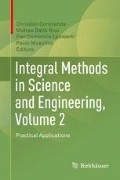Abstract
Potential flow problems with spatially varying transport coefficients are commonplace. While numerical methods are often implemented for such problems, coupled analytic solutions to heterogeneous, anisotropic problems enable below-grid, nonlinear flow effects to be accurately captured, even for systems with complex source functions. Coupling occurs through construction of boundary integrals to capture material transport between homogeneous domains. Various nonparametric methods are examined to compute the unknown flux distribution, including Gauss node distribution schemes with point source functions and patch-wise, semi-analytic integration. The merits of a posed parametric method that asserts a hybrid boundary condition and avoids numerical integration altogether within an overall analytic structure are further examined here. Reduction of heterogeneous problems to equivalent homogeneous transport property problems yields an additional term with linkage to uniform flux and uniform pressure contributions at increasingly distance interfaces in prolonged systems.
Access this chapter
Tax calculation will be finalised at checkout
Purchases are for personal use only
References
Babu, D., Odeh, A.: Productivity of a horizontal well. SPE Reserv. Eng. 4(4), 417–421 (1989)
Bromwich, T.J.I’A.: An Introduction to the Theory of Infinite Series. Macmillan and Co., London (1908)
Constanda, C.: Direct and Indirect Boundary Integral Equation Methods. Chapman & Hall/CRC, Boca Raton (2000)
Dogru, A.H.: Giga-cell simulation. Saudi Aramco J. Technol. Spring, 2–7 (2011)
Durlofsky, L.J.: Advanced techniques for reservoir simulation and modeling of non-conventional wells. Final Report, DOE Award DE-AC26-99BC15213. Department of Petroleum Engineering, Stanford University (2004)
Economides, M.J., Deimbacher, F.X., Brand, C.W. et al.: Comprehensive simulation of horizontal-well performance. SPE Form. Eval. 6(4), 418–426 (1991)
Economides, M.J., Brand, C.W., Frick, T.P.: Well configurations in anisotropic reservoirs. SPE Form. Eval. 11(4), 257–262 (1996)
Gradshteyn, I.S.,Ryzhik, I.M.: Table of Series Integrals and Products. Academic, New York (1980)
Hazlett, R.D., Babu, D.K.: Optimal well placement in heterogeneous reservoirs through semianalytic modeling. SPE J. 10(03), 286–296 (2005)
Hazlett, R., Babu, D.: Readily computable Green’s and Neumann functions for symmetry-preserving triangles. Q. Appl. Math. 67(3), 579–592 (2009)
Hazlett, R., Babu, D.: Influence of cell boundary flux distribution on well pressure. Proc. Comput. Sci. 18, 2137–2146 (2013)
Hazlett, R.D., Babu, D.K.: Discrete wellbore and fracture productivity modeling for unconventional wells and unconventional reservoirs. SPE J. 19(01), 19–33 (2014)
Kikani, J., Horne, R.N.: Modeling pressure-transient behavior of sectionally homogeneous reservoirs by the boundary-element method. SPE Form. Eval. 8(2), 145–152 (1993)
Lough, M.F., Lee, S.H., Kamath, J.: An efficient boundary integral formulation for flow through fractured porous media. J. Comput. Phys. 143(2), 462–483 (1998)
Maizeret, P.-D.: Well indices for non conventional wells. MS Thesis, Stanford University, Stanford (1996)
Masukawa, J., Horne, R.N.: Application of the boundary integral method to immiscible displacement problems. SPE Reserv. Eng. 3(03), 1069–1077 (1988)
McCann, R.C., Hazlett, R.D., Babu, D.K.: Highly accurate approximations of Green’s and Neumann functions on rectangular domains. Proc. R. Soc. Lond. A Math. Phys. Eng. Sci. 457(2008), 767–772 (2001)
Newman, A.B.: Heating and cooling rectangular and cylindrical solids. Ind. Eng. Chem. 28(5), 545–548 (1936)
Odeh, A.S., Babu, D.K.: Transient flow behavior of horizontal wells pressure drawdown and buildup analysis. SPE Form. Eval. 5(01), 7–15 (1990)
Stroud, A.H.: Approximate Calculation of Multiple Integrals. Prentice-Hall, Englewood Cliffs (1971)
Wolfsteiner, C., Durlofsky, L.J., Aziz, K.: Calculation of well index for nonconventional wells on arbitrary grids. Comput. Geosci. 7, 61–82 (2003)
Zhang, Y.: Parametric representation of boundary flux in heterogeneous potential flow problems. MS Thesis, University of Tulsa, Tulsa (2015)
Zhang, Y., Hazlett, R.D.: Parametric representation of cell boundary flux distributions in well equations. J. Comput. Appl. Math. 307, 65–71 (2016)
Acknowledgements
I gratefully acknowledge the immense contributions of my longtime collaborator in this field of investigation, Dr. D. Krishna Babu.
Author information
Authors and Affiliations
Corresponding author
Editor information
Editors and Affiliations
Appendix: Partial Integration of the Neumann Function on a Boundary
Appendix: Partial Integration of the Neumann Function on a Boundary
In patch-wise uniform flux boundary elements, assuming \(\frac{a^{2}} {k_{x}} =\max (\frac{a^{2}} {k_{x}}, \frac{b^{2}} {k_{y}}, \frac{h^{2}} {k_{z}})\), we examine partial integration of the point source Neumann function on the boundary as t \(\rightarrow \infty\). Focusing on the triple infinite series term requiring computational advantage, we obtain the following:
where
The first term on the RHS can be reduced to a single series with exponential damping, whereas the hyperbolic functions are replaced with exponentials and reformulated in terms of a rapidly convergent double infinite series with exponential damping.
If \(\frac{h^{2}} {k_{z}} \geq \frac{b^{2}} {k_{y}}\), then
The portion in parentheses can be further reduced. Otherwise,
Concerning the second term in the integration,
This last term can be efficiently coded with termination of infinite summations to desired accuracy.
Rights and permissions
Copyright information
© 2017 Springer International Publishing AG
About this chapter
Cite this chapter
Hazlett, R.D. (2017). Flux Characterization in Heterogeneous Transport Problems by the Boundary Integral Method. In: Constanda, C., Dalla Riva, M., Lamberti, P., Musolino, P. (eds) Integral Methods in Science and Engineering, Volume 2. Birkhäuser, Cham. https://doi.org/10.1007/978-3-319-59387-6_12
Download citation
DOI: https://doi.org/10.1007/978-3-319-59387-6_12
Published:
Publisher Name: Birkhäuser, Cham
Print ISBN: 978-3-319-59386-9
Online ISBN: 978-3-319-59387-6
eBook Packages: Mathematics and StatisticsMathematics and Statistics (R0)

